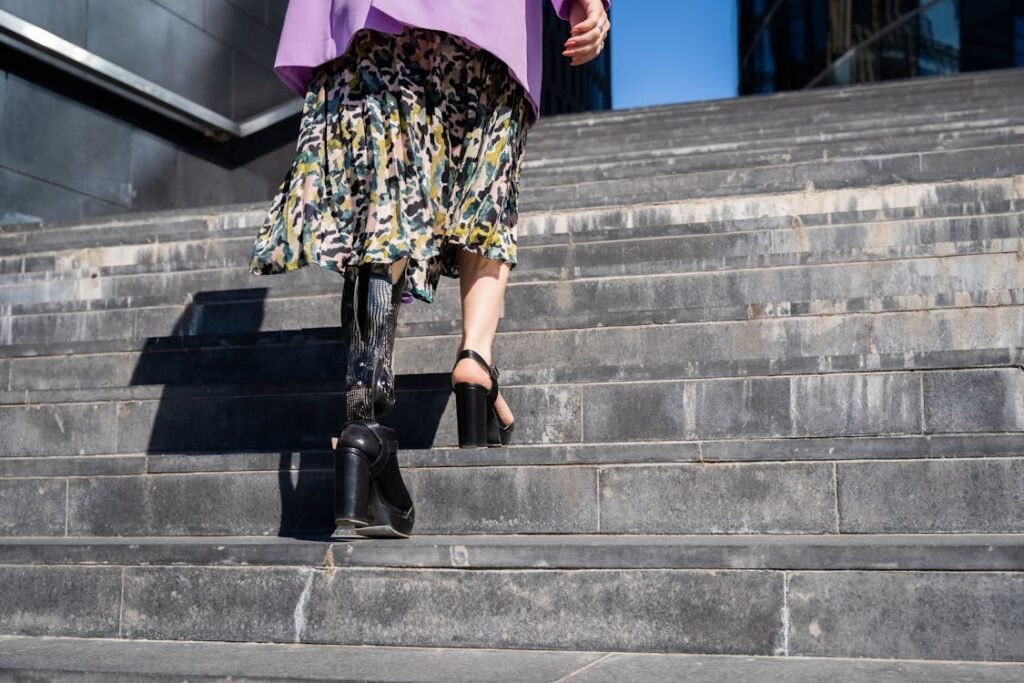Recovering from an amputation is about more than just learning to use a prosthetic limb. It’s about rebuilding strength, balance, and confidence in your body. One of the most important but often overlooked aspects of recovery is core strength.
The core is not just the abdominal muscles—it includes the muscles in the lower back, hips, and pelvis. These muscles stabilize the body, support movement, and help maintain balance. After an amputation, the body must adjust to a new way of moving, and a strong core plays a crucial role in making that transition smoother.
Many amputees experience difficulty with balance, posture, and fatigue. Weak core muscles can make these challenges even harder. Strengthening the core helps improve stability, reduces strain on other muscles, and makes using a prosthetic limb easier and more natural. It also plays a key role in preventing falls and injuries.
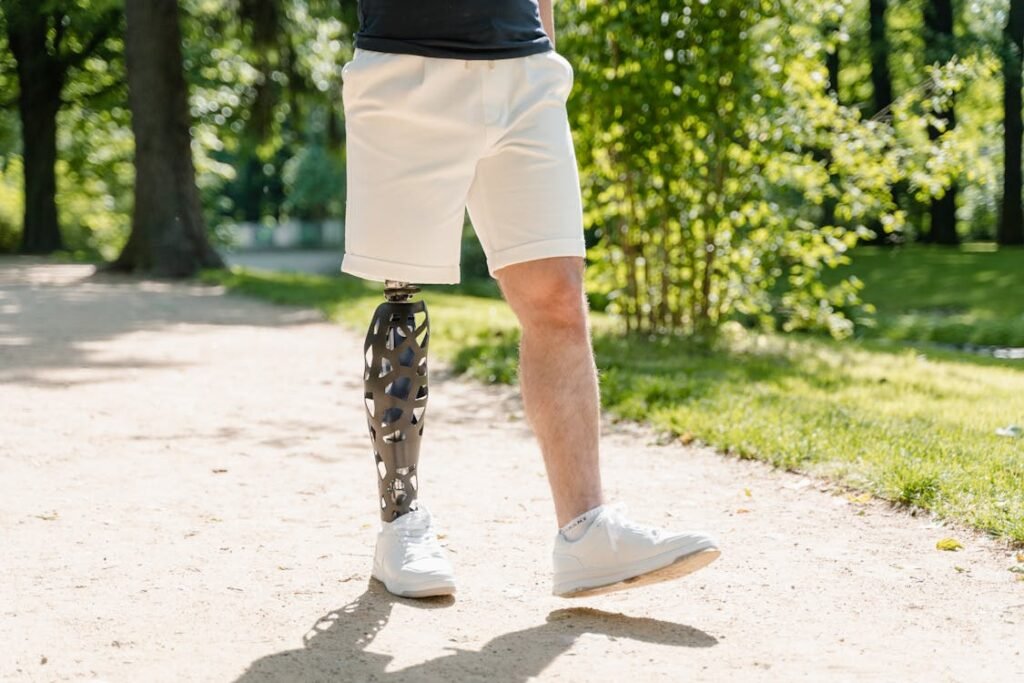
Why Core Strength is Essential After an Amputation
After an amputation, the body goes through significant changes. Without one or more limbs, the body’s natural balance is altered, and new movement patterns must be developed.
The muscles in the core become even more important because they provide the foundation for stability and mobility. When the core is weak, the body compensates by putting excess strain on other areas, leading to discomfort, poor posture, and a higher risk of injury.
Stability and Balance in Everyday Movements
For an amputee, everyday movements such as standing, walking, or shifting positions require far more control than before. A strong core helps stabilize the body, making movements smoother and more controlled.
When using a prosthetic limb, the body must adjust to its weight and mechanics. Without good core strength, it can be difficult to maintain balance, leading to frequent falls or instability.
The core muscles act like a natural support system, keeping the body upright and steady. Whether getting out of a chair, stepping over an obstacle, or reaching for an object, a strong core makes each movement easier and safer.
Amputees who focus on core training often find that they regain confidence in their movements much faster than those who neglect this part of rehabilitation.
Reducing Strain on the Joints and Back
One of the biggest complaints among amputees is back pain. This happens because the body naturally compensates for the missing limb by shifting weight to one side.
Over time, this imbalance puts extra stress on the spine, hips, and remaining limbs. A strong core helps distribute weight evenly, reducing strain on these areas and preventing long-term pain and discomfort.
For those using a prosthetic leg, proper posture is crucial. If the core muscles are weak, the lower back takes on more strain, leading to poor alignment and fatigue.
Strengthening the core supports the lower back, keeping the spine in a neutral position and making it easier to walk or stand for long periods without discomfort.
Improving Energy Efficiency
Moving with a prosthetic limb requires more energy than moving with natural limbs. When the core is weak, the body has to work harder to maintain balance and stability.
This leads to increased fatigue, making it difficult to stay active for long periods. With a strong core, movements become more efficient, reducing the overall energy required to walk, climb stairs, or perform daily tasks.
Amputees who focus on core strength often find that they have better endurance throughout the day. Whether they are working, exercising, or simply spending time with family, they feel less tired and more capable of staying active.
Strong core muscles help make every movement smoother and more controlled, allowing for a more comfortable and independent lifestyle.

How Core Strength Affects Prosthetic Use
Using a prosthetic limb is a learning process. It takes time for the body to adjust to the weight, movement, and mechanics of the prosthetic.
Without a strong core, this adjustment can feel much harder. Core strength directly affects how well an amputee adapts to their prosthetic, making movement more natural, stable, and efficient.
Achieving Better Control and Coordination
A prosthetic limb does not automatically move like a natural one. It requires conscious effort and coordination to step, balance, and shift weight properly.
This is where core strength becomes essential. The muscles in the abdomen, lower back, and pelvis work together to stabilize the body with every movement. When these muscles are strong, amputees find it easier to control their prosthetic limb and move with greater confidence.
Many new prosthetic users struggle with uneven weight distribution, especially when walking or standing for long periods. A weak core makes this issue worse, causing an unsteady gait and increasing the risk of falls.
By strengthening the core, the body can distribute weight more evenly, improving coordination and control over the prosthetic limb.
Enhancing Gait and Walking Efficiency
One of the biggest challenges for lower-limb amputees is walking smoothly and naturally. A weak core can lead to compensatory movements, such as excessive swaying, leaning, or an uneven stride.
These inefficient movements not only make walking more tiring but also increase strain on the back and joints.
When the core is strong, the pelvis and lower back stay stable, allowing for a more balanced and efficient gait. Walking becomes smoother, with less strain on the remaining limb and prosthetic.
This leads to improved endurance, reduced discomfort, and a more natural walking pattern.
Supporting Upper-Limb Prosthetic Users
Core strength is equally important for individuals with upper-limb amputations. The absence of an arm can create imbalances in posture, causing the shoulders and spine to compensate for the missing limb. This often results in shoulder pain, back tension, and poor alignment.
By strengthening the core, upper-limb amputees can maintain better posture and stability, reducing strain on the spine.
This is especially important when using an upper-limb prosthetic, as the added weight of the device can shift balance and posture. A strong core helps distribute this weight more effectively, making it easier to use the prosthetic for extended periods without discomfort.
Preventing Secondary Complications
Long-term prosthetic use can sometimes lead to secondary issues, such as joint pain, muscle fatigue, and misalignment of the spine. These problems often stem from poor posture, weak core muscles, and compensatory movements.
By focusing on core strength, amputees can prevent these complications before they start.
A well-conditioned core supports the spine, improves posture, and reduces unnecessary strain on the body, leading to a healthier and more comfortable experience with a prosthetic limb.
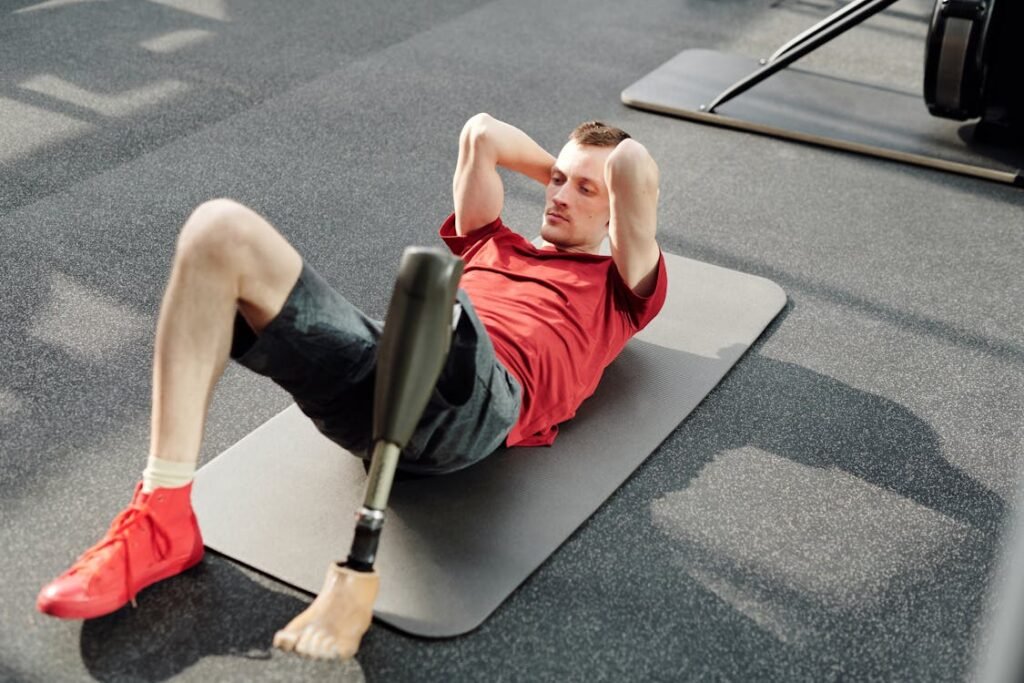
Exercises to Strengthen the Core for Post-Amputation Recovery
Building core strength is not about doing endless sit-ups or crunches. It involves activating deep muscles in the abdomen, lower back, and pelvis to create stability and balance.
For amputees, the right exercises focus on control, endurance, and functional movement rather than just muscle size. The goal is to improve mobility, posture, and prosthetic use in everyday life.
Safe and Effective Core Workouts
The best core exercises for amputees are those that improve balance, coordination, and strength without putting excessive strain on the joints. Many of these movements can be done at home with minimal equipment, making them easy to incorporate into a daily routine.
Seated exercises are ideal for beginners who need extra stability while building core strength. Simple movements like seated torso twists and seated marches help engage the core without requiring full weight-bearing.
These exercises train the body to stabilize itself, which is essential for maintaining balance when standing or walking with a prosthetic.
For those who are more mobile, planks, leg lifts, and pelvic tilts can significantly improve core endurance. Holding a plank, even for a few seconds, strengthens the entire midsection and improves posture.
Over time, these exercises make it easier to stand, walk, and perform daily tasks with better control.
Balance-focused movements are especially beneficial for lower-limb amputees. Standing on one leg (with support if needed), shifting weight from side to side, or using a stability ball can help train the deep core muscles responsible for maintaining balance.
This type of training is key to preventing falls and increasing confidence in movement.
Engaging the Core in Everyday Activities
Core strength does not come only from dedicated workouts—it develops through consistent activation during daily activities.
Something as simple as sitting upright in a chair, engaging the abdominal muscles while reaching for an object, or practicing controlled breathing while moving can improve core stability over time.
Using a prosthetic limb correctly also requires constant core engagement.
When walking, shifting weight, or climbing stairs, focusing on using the core muscles rather than just the legs can lead to smoother, more controlled movements. This habit gradually builds strength and makes mobility feel more natural.
The Role of Physical Therapy in Core Training
A structured rehabilitation program, led by a physical therapist, can tailor core-strengthening exercises to an individual’s needs.
Therapists can assess posture, movement patterns, and balance issues, designing a routine that helps improve core function while avoiding unnecessary strain.
For amputees who are new to exercise, working with a professional ensures that movements are done safely and effectively. It also helps in tracking progress and making adjustments based on individual capabilities and recovery goals.
A strong core is the foundation for better movement, greater confidence, and long-term success with a prosthetic limb. By making core exercises a regular part of rehabilitation, amputees can experience improved balance, reduced pain, and more energy for daily life.

Long-Term Benefits of Core Strength in Everyday Life
Building core strength is not just about rehabilitation; it has long-term benefits that continue well beyond the initial recovery phase. A strong core plays a critical role in helping amputees lead an active, independent, and pain-free life.
Whether it’s standing for long periods, walking with ease, or simply feeling more stable, the core is at the center of every movement the body makes.
Improving Posture and Reducing Chronic Pain
One of the biggest long-term challenges after an amputation is maintaining proper posture. When a limb is lost, the body naturally compensates by shifting weight to one side.
This imbalance can lead to chronic pain in the lower back, hips, or shoulders over time. Many amputees experience spinal misalignment, which can make simple movements uncomfortable.
A strong core helps maintain a neutral spine position, distributing weight more evenly and preventing excessive stress on any one part of the body.
This leads to better posture, less pain, and improved movement efficiency. Those who focus on core training early in their recovery often experience fewer long-term mobility issues and a lower risk of secondary complications.
Preventing Falls and Injuries
One of the most common concerns for amputees, especially those using a prosthetic limb, is the risk of falling. A fall can cause serious injuries, setbacks in rehabilitation, and even a loss of confidence in movement.
Core strength directly impacts balance, making falls less likely by improving the body’s ability to adjust to sudden shifts in position.
With a well-conditioned core, amputees can react more quickly if they stumble, regaining balance before a fall occurs.
This level of control is essential not just for safety, but for feeling comfortable and secure while moving in different environments, from uneven sidewalks to crowded public spaces.
Enhancing Endurance and Energy Levels
Many amputees find that daily activities, such as walking, standing, or climbing stairs, require much more energy and effort compared to before their amputation.
This is because the body is working harder to stabilize itself and compensate for the missing limb. A weak core makes this problem worse, leading to faster fatigue and discomfort.
By strengthening the core, the body becomes more efficient in movement, reducing the amount of energy needed for each step.
This translates to better endurance throughout the day, making it easier to stay active, work, socialize, and engage in hobbies without feeling constantly exhausted.
Supporting Long-Term Prosthetic Use
For amputees who use prosthetics, core strength is a lifelong necessity. Over time, changes in body weight, muscle distribution, and prosthetic adjustments require the body to constantly adapt.
A well-trained core makes these transitions smoother and less physically demanding.
Amputees who keep their core strong find it easier to adjust to new prosthetic devices, recover more quickly from minor setbacks, and maintain greater independence in the long run.
Core strength ensures that the body remains resilient, adaptable, and prepared for future challenges.
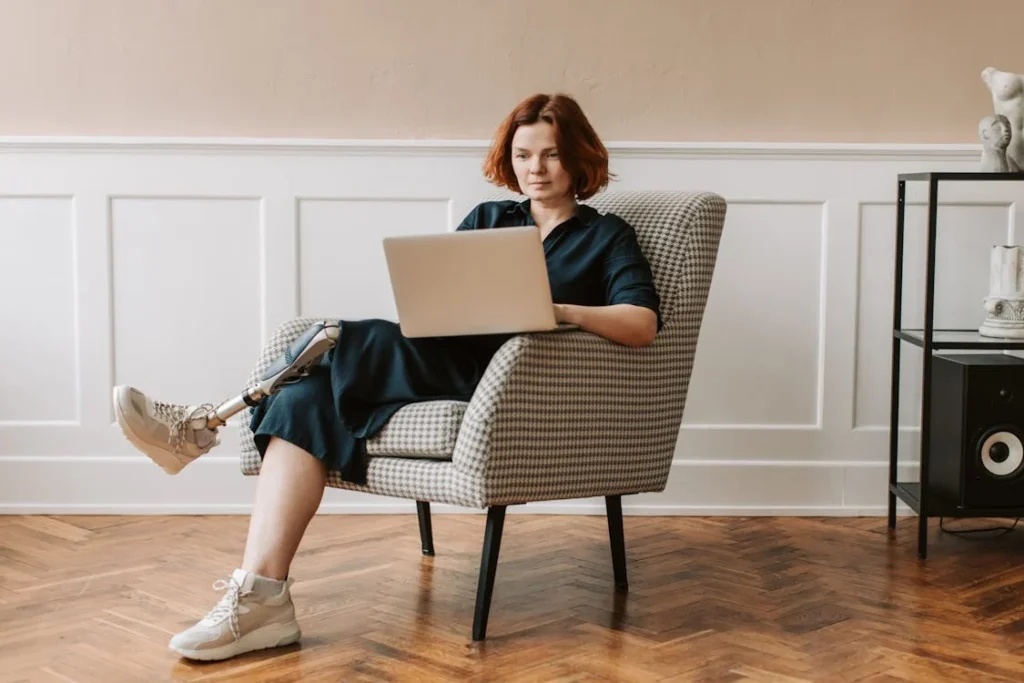
How Core Strength Affects Mental and Emotional Well-Being
Post-amputation recovery is not just about physical rehabilitation. Mental and emotional well-being play a huge role in adapting to life after limb loss.
Many amputees face challenges such as frustration, anxiety, and loss of confidence in their body’s abilities. What often surprises people is that core strength is directly linked to emotional resilience.
The Mind-Body Connection in Recovery
When core muscles are weak, movement feels unsteady and exhausting. This can create fear and hesitation when performing simple tasks like walking or standing.
Many amputees develop a subconscious fear of falling, which can lead to less movement, less activity, and a loss of confidence. Over time, this can result in a cycle of inactivity and emotional distress.
Strengthening the core improves physical control and stability, which naturally leads to a boost in confidence. When the body feels strong, the mind follows.
Amputees who incorporate core training into their rehabilitation often experience greater self-assurance, allowing them to engage more freely in social activities, work, and hobbies.
Reducing Stress and Improving Mood
Regular core exercises trigger the release of endorphins, the body’s natural stress-relievers. These chemicals help combat depression, reduce anxiety, and improve overall mood.
Many amputees report feeling more positive and energized after exercise, even if they were feeling low before starting.
Additionally, focusing on physical movement provides a mental break from worries about recovery and limitations. Exercises that engage the core, such as yoga or Pilates, also incorporate breathing techniques that promote relaxation and reduce stress.
Overcoming Mental Barriers to Movement
One of the biggest mental hurdles after an amputation is trusting the body again. Many amputees hesitate to move freely because they fear falling or failing.
Core training helps break down these mental barriers by creating stability, control, and a sense of physical empowerment.
The more an individual practices balance and coordination, the more their brain adapts to their new way of moving.
This not only improves physical performance but also strengthens mental resilience, making it easier to embrace new challenges with determination rather than fear.
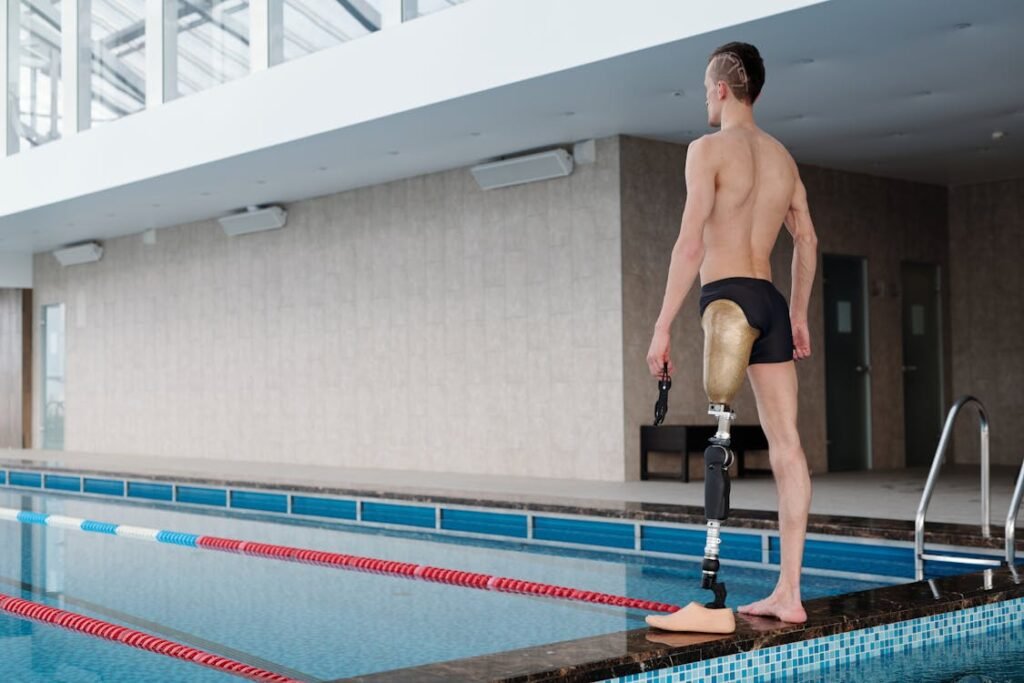
Core Strength and Its Role in Sports and Active Lifestyles
For many amputees, returning to an active lifestyle is a major goal. Whether it’s recreational activities like swimming and hiking or competitive sports like running and wheelchair basketball, core strength is essential for performance, endurance, and injury prevention.
Improving Athletic Performance for Amputees
Athletes, whether able-bodied or amputees, rely heavily on their core for power, agility, and stability. Sports require quick adjustments in movement, and a weak core can make those movements inefficient and exhausting.
For lower-limb amputees, strong core muscles allow for better weight distribution and smoother motion, reducing the strain on the prosthetic limb.
This makes activities like sprinting, cycling, and climbing more efficient and less tiring.
Upper-limb amputees also benefit greatly from core training. Sports such as rowing, archery, and wheelchair tennis require postural control and upper-body coordination, both of which depend on a stable core.
Without this foundation, movements become unbalanced and lead to faster fatigue or improper technique.
Preventing Sports-Related Injuries
A weak core can lead to poor movement mechanics, which increases the risk of injuries. Amputee athletes who neglect core training often experience back pain, joint strain, and muscle imbalances due to uneven weight distribution.
Strengthening the core reduces excess pressure on joints, especially for those using prosthetic limbs. It helps the body absorb impact better, making high-intensity activities safer and more sustainable in the long run.
Enhancing Endurance for Daily Activities
Even if an amputee does not participate in sports, an active lifestyle still requires endurance. Walking for long periods, carrying groceries, or standing while cooking can be tiring if core muscles are weak.
Core training enhances muscle endurance, meaning the body can maintain physical activity for longer periods without discomfort. This directly improves quality of life, allowing amputees to engage in their favorite activities with more energy and less effort.

How Core Strength Helps with Prosthetic Adjustments Over Time
Prosthetic limbs are not static. Over time, adjustments are needed due to changes in body weight, muscle tone, or daily activity levels. A strong core makes it easier to adapt to these changes without disrupting movement patterns.
Adjusting to a New Prosthetic Limb
When switching to a new prosthetic limb, the body needs time to relearn movement mechanics. If the core is weak, this adjustment period can be much longer and more frustrating.
A strong core allows for better control and quicker adaptation, reducing the discomfort that often comes with transitioning to a different device.
Compensating for Changes in Mobility
As time goes on, an amputee’s mobility may change due to aging, weight fluctuations, or new physical challenges. Core strength ensures that the body can compensate for these changes, preventing additional strain on the spine, hips, and remaining limbs.
Amputees who consistently train their core find that they maintain mobility and independence longer, even as their prosthetic needs evolve. This means fewer complications, less discomfort, and a greater ability to stay active well into the future.
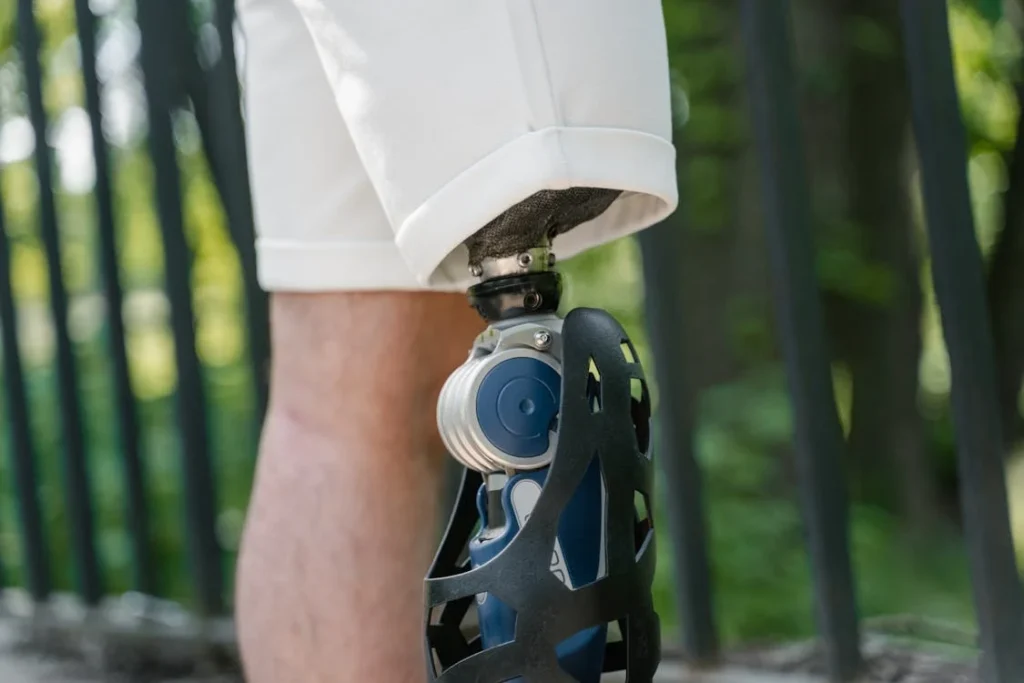
Why Every Amputee Should Prioritize Core Training
Core strength is not just an optional part of post-amputation recovery—it is a necessity for stability, movement, and long-term health.
Whether someone is just beginning rehabilitation, learning to use a prosthetic, or pursuing an active lifestyle, a strong core serves as the foundation for everything from balance and endurance to confidence and independence.
Transforming Recovery into Empowerment
Many amputees start rehabilitation feeling uncertain about their physical abilities. Core training helps shift this mindset from “I can’t” to “I can.”
By strengthening the core, individuals regain control over their movements, reduce discomfort, and rebuild confidence in their bodies.
Making Every Movement Easier
From standing up to walking longer distances, a strong core makes daily life more comfortable and effortless. Tasks that once felt difficult become second nature, allowing amputees to focus on living life to the fullest rather than worrying about mobility limitations.
Building a Future of Strength and Independence
By prioritizing core strength, amputees invest in their long-term health and well-being. They create a body that is resilient, adaptable, and capable, no matter what challenges arise.
This not only enhances daily life but also ensures greater independence and freedom for years to come.
Conclusion
Recovering from an amputation is a journey that goes beyond simply learning to use a prosthetic limb. It requires strength, stability, and confidence, all of which come from a well-conditioned core. Core strength is the foundation for better balance, smoother movement, reduced pain, and long-term mobility.
A strong core not only makes walking, standing, and daily tasks easier—it also helps prevent injuries, reduces strain on the back and joints, and improves posture. Over time, it allows amputees to move with greater ease, conserve energy, and stay active for longer periods without fatigue.
At Robobionics, we are committed to empowering individuals with limb loss by providing cutting-edge prosthetic solutions like Grippy™, our advanced bionic hand. But we also believe that rehabilitation should focus on building overall strength and mobility to ensure a seamless transition into prosthetic use.
Are you ready to improve your mobility and regain independence? Book a free demo of Grippy™ today and take the next step in your recovery journey!



